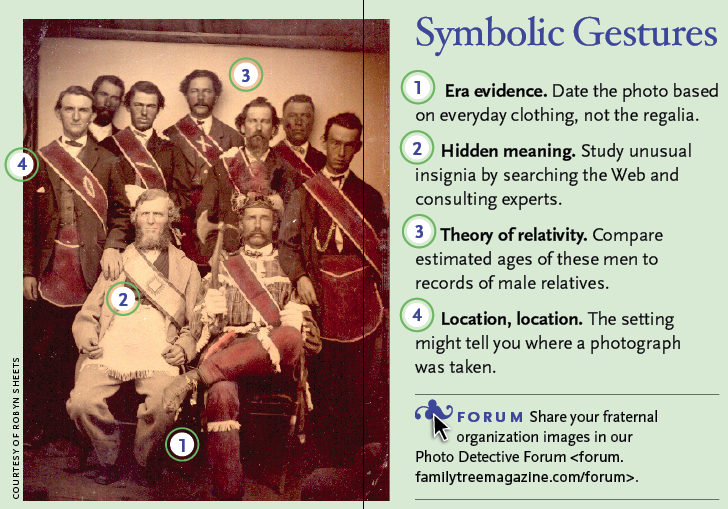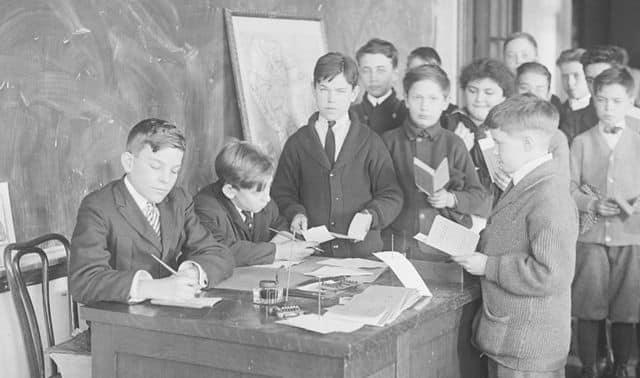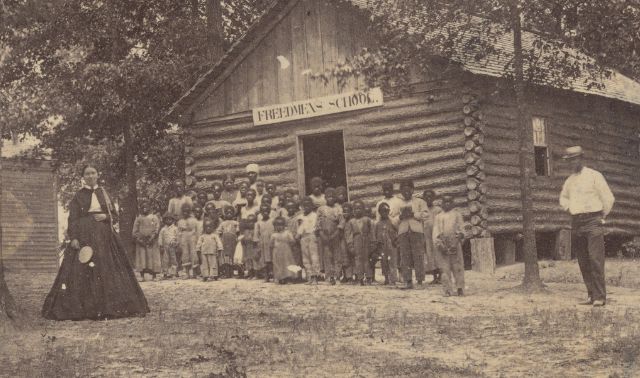Sign up for the Family Tree Newsletter Plus, you’ll receive our 10 Essential Genealogy Research Forms PDF as a special thank you!
Get Your Free Genealogy Forms
"*" indicates required fields
Interesting headgear, intriguing aprons and decorative sashes add up to a dilemma for family historian Robyn Sheets. “Who are these men?” and “What are they wearing?” are two questions that come immediately to mind.
Even though fraternal organizations’ rites and rituals were secret, members of these organizations would often broadcast their membership by wearing pins or other jewelry. The symbols in this photo identify the group as a fraternal organization, but it’s unclear which one.
Fraternal organizations provided members with both social networks for doing business and support in the form of life insurance and other assistance. Historically, groups typically formed around a common homeland (such as the Ancient Order of Hibernians, an Irish organization), occupation (the Masons began as a guild for stonemasons) or some other affiliation.
Sheets’ photo mystery involves a plethora of details on fraternal organizations and plenty of research avenues. Let’s explore some of them.
Go on a date
Photos featuring fraternal costumes are best dated using the everyday clothing worn underneath the regalia. The small bow ties and collars combined with jackets suggest this tintype image was taken between the late 1860s and early 1870s. Sheets knows this image belonged to her maternal grandmother, so she should start her identification process by making a list of men in that family branch who were alive around this time.
The men could’ve posed in the photographer’s studio, but the narrow room (see the wall to the let of the men?) and simple backdrop raise the possibility the setting is the group’s lodge. Interestingly, the photographer hand-painted the men’s sashes and the pants of the man seated on the right.

Examine the possibilities
Sheets should check other family pictures to see if any men wear similar insignia. To figure out which group these men belonged to, she should try to learn the names of fraternal organizations in the areas where her ancestors lived. City directories often have lists. Sheets also can research any relatives she thinks may be in this photo for clues to fraternal affiliation, using resources such as:
- Obituaries: In death notices for her relatives, Sheets could discover mention of fraternal membership.
- Cemetery markers: A gravestone may bear a symbol of the deceased’s fraternal organization. A handy pictorial list of commonly found insignia appears in Douglas Keister’s Stories in Stone: A Field Guide to Cemetery Symbolism and Iconography (Gibbs Smith).
- Manuscripts: Look for letters, diaries and membership papers in family collections. Sheets has an old letter documenting an ancestor’s membership in the Masons.
Work your network
The local historical society where an ancestor lived might have information, records and photographs from fraternal organizations in the vicinity. Sheets can search for images with insignia similar to what’s in her photo. She also could type the names of her ancestors’ local fraternal organizations into an image search engine (such as Google Images), looking for symbols that match the ones shown here.
Sheets knows the men in several generations of her Waltz family of Frederick, Md., were Masons. I contacted the Masonic Grand Lodge of Maryland, but the group’s historian didn’t think these men were members.
Next I asked Rhonda McClure, a genealogist with the New England Historic Genealogical Society
and an expert on fraternal organizations, to take a look at this image. She suggested it could depict members of the Improved Order of Red Men (IORM), a group that originated in 1765 as the Sons of Liberty, who participated in the Boston Tea Party.
That clue led me to David Lintz, director of the Red Men Library and Museum. He identified the group as “Chiefs of the Tribe” (lodge officers), probably of the IORM’s Frederick, Md., Chippewa Lodge No. 19, which was established in 1856 and still exists. “The man in regalia with the tomahawk is probably the Sachem (tribe president),” Lintz writes. “The man next to him with white apron and sash is the Prophet (past president).” The rest of the men in the image are likely other elected officers.
Sheets’ photo depicting men linked by fellowship is a real gem. Once she knows which relative was a member of this organization, she can contact the organization’s administrative office to ask about historical records—a potential family history treasure trove. To learn more about the IORM, she can read the 1893 book Official History of the Improved Order of the Red Men by Charles H. Litchman. It’s available though Google Books; you can access it in our Google Library.
From the November 2008 Family Tree Magazine
ADVERTISEMENT


